From River to Sea: Tracking Plastic Waste Transport via the Hau River, Mekong Delta, Vietnam
Abstract
1. Introduction
2. Materials and Methods
2.1. Study Areas
2.1.1. Characteristics of Hau River
2.1.2. Hau River Hydrological Regime
2.2. Sample Collection
2.2.1. Sample Collection Time
2.2.2. Sample Collection Net
2.3. Data Collection
2.4. Calculate the Collected Data
2.4.1. Calculation of the Flow Volume Through the Devices
2.4.2. Concentration, Size Categories, and Chemical Composition of Macroplastic
3. Results
3.1. Meteorological Factors
3.1.1. Air Humidity and Air Temperature
3.1.2. Wind Direction and Wind Speed
3.2. Hydrological Characteristics
3.2.1. Waves on the Hau River
3.2.2. Water Velocity
3.3. Characteristics of Floating Plastic Waste
3.3.1. Abundance of Plastic Items
Abundance of Plastic Items at Ebb Tide
Abundance of Plastic Items at Flood Tide
3.3.2. Number of Pieces of Plastic
Density of Plastic Pieces According to Each Tidal Time
Number of Plastic Items at Ebb Tide
Number of Plastic Items at Flood Tide
3.3.3. Mass of Plastics
Plastic Mass Density at Each Tidal Time
Mass Distribution of Plastic Debris at Ebb Tide
Mass Distribution of Plastic Debris at Flood Tide
3.3.4. Plastic Size Distribution
4. Conclusions
Author Contributions
Funding
Data Availability Statement
Conflicts of Interest
References
- OECD. Global Plastics Outlook: Economic Drivers, Environmental Impacts and Policy Options; OECD Publishing: Paris, France, 2022; Available online: https://espas.secure.europarl.europa.eu/orbis/system/files/generated/document/en/plastic.pdf (accessed on 6 May 2024).
- UNDP. Environment Week 2023: Joining Forces to Beat Plastic Pollution. 2023. Available online: https://www.undp.org/suriname/press-releases/environment-week-2023-joining-forces-beat-plastic-pollution (accessed on 6 May 2024).
- Lebreton, L.C.M.; Van der Zwet, J.; Damsteeg, J.W.; Slat, B.; Andrady, A.; Reisser, J. River plastic emissions to the world’s oceans. Nat. Commun. 2017, 8, 15611. [Google Scholar] [CrossRef]
- Van Calcar, C.J.; van Emmerik, T.H.M. Abundance of plastic debris across European and Asian rivers. Environ. Res. Lett. 2019, 14, 124051. [Google Scholar] [CrossRef]
- WWF-Vietnam. Report on Plastic Waste Generation in 2022; Thanh Nien Publishing House: Hanoi, Vietnam, 2023; Available online: https://wwfasia.awsassets.panda.org/downloads/wwf_a4_bao-cao-chat-thai-nhua-final--a--ne-n.pdf (accessed on 6 May 2024). (In Vietnamese)
- Anh, N. Every Year Vietnam Releases 1.8 Million Tons of Plastic Waste into the Environment. 2024. Available online: https://vneconomy.vn/moi-nam-viet-nam-thai-ra-moi-truong-1-8-trieu-tan-rac-thai-nhua.htm (accessed on 6 May 2024). (In Vietnamese).
- MCD. Reducing Plastic Waste Pollution on the Red River—Results and Lessons Learned from Nam Dinh. 2023. Available online: https://mcdvietnam.org/giam-thieu-o-nhiem-rac-thai-nhua-tren-song-hong-nhung-ket-qua-va-bai-hoc-kinh-nghiem-tu-nam-dinh (accessed on 6 May 2024). (In Vietnamese).
- Department of Natural Resources and Environment of Nam Dinh Province. Project Summary Conference: “Reducing Plastic Waste Pollution on the Red River”. 2023. Available online: https://sotnmt.namdinh.gov.vn/vi-vn/tin-tuc/moi-truong-52/hoi-nghi-tong-ket-du-an-giam-thieu-o-nhiem-rac-thai-nhua-tren-song-hong (accessed on 6 May 2024). (In Vietnamese)
- Ministry of Natural Resources and Environment. Pressure of Plastic Waste in the Downstream of Vu Gia–Thu Bon River. 2019. Available online: https://baotainguyenmoitruong.vn/ap-luc-rac-thai-nhua-o-ha-luu-song-vu-gia-thu-bon-96374.html (accessed on 6 May 2024). (In Vietnamese).
- Chung, K.L.T.; Strady, E. Life Cycle of Floating Debris in the Canals of Ho Chi Minh City. 2016. Available online: https://horizon.documentation.ird.fr/exl-doc/pleins_textes/divers17-07/010070479.pdf (accessed on 6 May 2024).
- Thanh, P.D.; Hoang, B.T.; Dat, N.T.; Duy, N.H.; Son, T.B. Characteristics of Plastic Waste Floating on the Saigon River and Nha Be River. 2021. Available online: https://tapchimoitruong.vn/nghien-cuu-23/dac-diem-rac-nhua-noi-tren-song-sai-gon-va-song-nha-be-25536 (accessed on 6 May 2024). (In Vietnamese).
- Schmidt, C.; Krauth, T.; Wagner, S. Export of plastic debris by rivers into the sea. Environ. Sci. Technol. 2017, 51, 12246–12253. [Google Scholar] [CrossRef]
- Haberstroh, C.J.; Arias, M.E.; Yin, Z.; Sok, T.; Wang, M.C. Plastic transport in a complex confluence of the Mekong River in Cambodia. Environ. Res. Lett. 2021, 16, 095009. [Google Scholar] [CrossRef]
- IUCN. Program to Monitor and Evaluate Plastic Waste on Vietnam’s Coast—Report 2020. 2021. Available online: https://www.iucn.org/sites/default/files/content/documents/2021/beach_debris_mornitoring_2020_report_vietnamese_-_1_july_2021.pdf (accessed on 6 May 2024). (In Vietnamese).
- Mekong River Commission. State of the Basin Report 2018; Mekong River Commission: Vientiane, Laos, 2019; Available online: https://www.mrcmekong.org/wp-content/uploads/2024/08/State-of-the-Basin-Report-2018-1.pdf (accessed on 6 May 2024)ISSN 1728-3248.
- Quyen, N.T.K.; Berg, H.; Gallardo, W.; Da, C.T. Stakeholders’ perceptions of ecosystem services and Pangasius catfish farming development along the Hau River in the Mekong Delta, Vietnam. Ecosyst. Serv. 2017, 25, 2–14. [Google Scholar] [CrossRef]
- Tuan, L.A.; Hoang, T.T.; Vo, V.N. Water Resource Variation in the Hau River Mouth. J. Fish. Sci. Tech. Spec. Issues 2015, 2015, 50–56. [Google Scholar]
- An, L. Concerns About Environmental Pollution of the Hau River—Lesson 1: The Role of the Hau River. 2017. Available online: https://thuonghieucongluan.com.vn/noi-lo-o-nhiem-moi-truong-song-hau-bai-1-vai-tro-cua-song-hau-a39559.html (accessed on 6 May 2024). (In Vietnamese).
- Viet Nam National Mekong Committee. Mekong River Basin in Vietnam. 2021. Available online: https://vnmc.gov.vn/?p=719 (accessed on 6 May 2024). (In Vietnamese)
- Viet Nam National Mekong Committee. Mekong River Basin. 2021. Available online: https://vnmc.gov.vn/?page_id=1878 (accessed on 6 May 2024). (In Vietnamese)
- Tien, N.N.; Thanh, N.T.; Dang, V.H. Hydrodynamic and environmental characteristics during dry season in the Hau River mouth area. Viet. J. Mar. Sci. Tech. 2015, 15, 235–241. [Google Scholar] [CrossRef]
- Department of Natural Resources and Environment of An Giang Province. Distribution of Water Resources. 2023. Available online: https://sotainguyenmt.angiang.gov.vn/TongQuan_TNN1.aspx (accessed on 6 May 2024). (In Vietnamese)
- Dien, T.L.T. Research Forecasting the Stabilization of the Hau River Flowing Through An Giang Province and Proposing Appropriate Shore Protection Solutions. Ph.D. Thesis, Ho Chi Minh City University of Technology, Ho Chi Minh City, Vietnam, 2021. (In Vietnamese). [Google Scholar]
- Institute of Coastal and Offshore Engineering. Tide Table Forecast for 2024; Institute of Coastal and Offshore Engineering: Ho Chi Minh City, Vietnam, 2024. (In Vietnamese) [Google Scholar]
- UNEP. Monitoring Plastics in Rivers and Lakes: Guidelines for the Harmonization of Methodologies; United Nations Environment Programme: Nairobi, Kenya, 2020; Available online: https://wedocs.unep.org/xmlui/bitstream/handle/20.500.11822/35834/MPRLS.pdf (accessed on 6 May 2024)ISBN 978-92-807-3819-3.
- van Emmerik, T.; Kieu-Le, T.-C.; Loozen, M.; van Oeveren, K.; Strady, E.; Bui, X.-T.; Egger, M.; Gasperi, J.; Lebreton, L.; Nguyen, P.-D.; et al. A methodology to characterize riverine macroplastic emission into the ocean. Front. Mar. Sci. 2018, 5, 372. [Google Scholar] [CrossRef]
- Tramoy, R.; Gasperi, J.; Colasse, L.; Silvestre, M.; Dubois, P.; Noûs, C.; Tassin, B. Transfer dynamics of macroplastics in estuaries—New insights from the Seine estuary: Part 2. Short-term dynamics based on GPS-trackers. Mar. Pollut. Bull. 2020, 160, 111566. [Google Scholar] [CrossRef]
- González-Fernández, D.; Hanke, G. Toward a harmonized approach for monitoring of riverine floating macro litter inputs to the marine environment. Front. Mar. Sci. 2017, 4, 86. [Google Scholar] [CrossRef]
- Moore, C.J.; Lattin, G.L.; Zellers, A.F. Quantity and type of plastic debris flowing from two urban rivers to coastal waters and beaches of Southern California. J. Integr. Coast. Zone Manag. 2011, 11, 65–73. [Google Scholar] [CrossRef]
- SpecialChem. Density of Plastics: Technical Properties. 2024. Available online: https://omnexus.specialchem.com/polymer-property/density (accessed on 6 May 2024).
- Grigorescu, R.M.; Grigore, M.E.; Iancu, L.; Ghioca, P.; Ion, R.M. Waste electrical and electronic equipment: A review on the identification methods for polymeric materials. Recycling 2019, 4, 32. [Google Scholar] [CrossRef]
- UNEP. Agenda Item 4: Development of Guidelines for Monitoring Riverine Inputs of Marine Litter; United Nations Environment Programme: Nairobi, Kenya, 2022; Available online: https://wedocs.unep.org/bitstream/handle/20.500.11822/40264/22wg534_04_eng.pdf?sequence=1&isAllowed=y (accessed on 6 May 2024).
- General Oceanics, Inc. 2030 and 2031 Series Mechanical and Electronic Digital Flowmeter Operators Manual. 2018. Available online: https://www.generaloceanics.com/media/hexaattachment/products/attachments/2030_MANUAL.pdf (accessed on 6 May 2024).
- UNEP. Single-Use Plastics: A Roadmap for Sustainability; United Nations Environment Programme: Nairobi, Kenya, 2018; Available online: https://mpma.org.my/v4/wp-content/uploads/2020/12/7.-singleUsePlastic_sustainability.pdf (accessed on 6 May 2024)ISBN 978-92-807-3705-9.
- Kaiser, D.; Kowalski, N.; Waniek, J.J. Effects of Biofouling on the Sinking Behavior of Microplastics. Environ. Res. Lett. 2017, 12, 124003. [Google Scholar] [CrossRef]
- Gewert, B.; Plassmann, M.M.; MacLeod, M. Pathways for degradation of plastic polymers floating in the marine environment. Environ. Sci.: Processes Impacts 2015, 17, 1513–1521. [Google Scholar] [CrossRef]
- Lebreton, L.C.-M.; Greer, S.D.; Borrero, J.C. Numerical modelling of floating debris in the world’s oceans. Mar. Pollut. Bull. 2012, 64, 653–661. [Google Scholar] [CrossRef] [PubMed]
- Reisser, J.; Slat, B.; Noble, K.; du Plessis, K.; Epp, M.; Proietti, M.; de Sonneville, J.; Becker, T.; Pattiaratchi, C. The vertical distribution of buoyant plastics at sea: An observational study in the North Atlantic Gyre. Biogeosciences 2015, 12, 1249–1256. [Google Scholar] [CrossRef]
- Chen, Z.; Li, G.; Bowen, M.; Coco, G. Retention of Buoyant Plastic in a Well-Mixed Estuary Due to Tides, River Discharge and Winds. Mar. Pollut. Bull. 2023, 194, 115395. [Google Scholar] [CrossRef] [PubMed]
- Horton, A.A.; Walton, A.; Spurgeon, D.J.; Lahive, E.; Svendsen, C. Microplastics in freshwater and terrestrial environments: Evaluating the current understanding to identify the knowledge gaps and future research priorities. Sci. Total Environ. 2017, 586, 127–141. [Google Scholar] [CrossRef]
- Schreyers, L.J.; van Emmerik, T.H.; Bui, T.K.L.; Biermann, L.; Uijlenhoet, R.; Nguyen, H.Q.; Wallerstein, N.; van der Ploeg, M. Water hyacinths retain river plastics. Environ. Pollut. 2024, 356, 124118. [Google Scholar] [CrossRef]
- Dinh, T.; Soc Trang weather forecast. SocTrang Online. 2024. Available online: https://baosoctrang.org.vn/thoi-tiet/202404/du-bao-thoi-tiet-soc-trang-ngay-294-57e4a35/ (accessed on 6 May 2024). (In Vietnamese).
- Windsor, F.M.; Tilley, R.M.; Tyler, C.R.; Ormerod, S.J. Microplastic ingestion by riverine macroinvertebrates. Sci. Total Environ. 2019, 646, 68–74. [Google Scholar] [CrossRef]
- Jambeck, J.R.; Geyer, R.; Wilcox, C.; Siegler, T.R.; Perryman, M.; Andrady, A.; Law, K.L. Plastic waste inputs from land into the ocean. Science 2015, 347, 768–771. [Google Scholar] [CrossRef]
- van Emmerik, T.; Schwarz, A. Plastic debris in rivers. Wiley Interdiscip. Rev. Water 2019, 7, e1398. [Google Scholar] [CrossRef]
- Andrady, A.L. Microplastics in the marine environment. Mar. Pollut. Bull. 2011, 62, 1596–1605. [Google Scholar] [CrossRef]
- Rochman, C.M.; Hoh, E.; Kurobe, T.; Teh, S.J. Ingested plastic transfers hazardous chemicals to fish and induces hepatic stress. Sci. Rep. 2013, 3, 3263. [Google Scholar] [CrossRef]
- Wright, S.L.; Thompson, R.C.; Galloway, T.S. The physical impacts of microplastics on marine organisms: A review. Environ. Pollut. 2013, 178, 483–492. [Google Scholar] [CrossRef] [PubMed]
- UNEP. From Pollution to Solution: A Global Assessment of Marine Litter and Plastic Pollution; United Nations Environment Programme: Nairobi, Kenya, 2021. [Google Scholar]
- Rech, S.; Macaya-Caquilpán, V.; Pantoja, J.F.; Rivadeneira, M.M.; Jorquera, M.A.; Thiel, M. Rivers as a source of marine litter—A study from the SE Pacific. Mar. Pollut. Bull. 2014, 82, 66–75. [Google Scholar] [CrossRef]
- Hopewell, J.; Dvorak, R.; Kosior, E. Plastics recycling: Challenges and opportunities. Philos. Trans. R. Soc., B 2009, 364, 2115–2126. [Google Scholar] [CrossRef]
- Browne, M.A.; Crump, P.; Niven, S.J.; Teuten, E.; Tonkin, A.; Galloway, T.; Thompson, R. Accumulation of microplastic on shorelines worldwide: Sources and sinks. Environ. Sci. Technol. 2011, 45, 9175–9179. [Google Scholar] [CrossRef] [PubMed]
- Schreyers, L.J.; van Emmerik, T.H.; Bui, T.K.L.; van Thi, K.L.; Vermeulen, B.; Nguyen, H.Q.; Wallerstein, N.; Uijlenhoet, R.; van der Ploeg, M. River plastic transport affected by tidal dynamics. Hydrol. Earth Syst. Sci. 2024, 28, 589–610. [Google Scholar] [CrossRef]
- GESAMP. Sources, Fate and Effects of Microplastics in the Marine Environment: A Global Assessment; Rep. Stud. GESAMP No., 90, Kershaw, P.J., Eds.; IMO/FAO/UNESCO-IOC/UNIDO/WMO/IAEA/UN/UNEP/UNDP Joint Group of Experts on the Scientific Aspects of Marine Environmental Protection: London, UK, 2015; 96p, Available online: http://www.gesamp.org/publications/reports-and-studies-no-90 (accessed on 6 May 2024).
- Li, J.; Liu, H.; Chen, J.P. Microplastics in freshwater systems: A review on occurrence, environmental effects, and methods for microplastics detection. Water Res. 2018, 137, 362–374. [Google Scholar] [CrossRef] [PubMed]
- Corcoran, P.L.; Biesinger, M.C.; Grifi, M. Plastics and beaches: A degrading relationship. Mar. Pollut. Bull. 2009, 58, 80–84. [Google Scholar] [CrossRef] [PubMed]
- Blettler, M.C.; Ulla, M.A.; Rabuffetti, A.P.; Garello, N. Plastic pollution in freshwater ecosystems: Macro-, meso-, and microplastic debris in a floodplain lake. Environ. Monit. Assess. 2017, 189, 581. [Google Scholar] [CrossRef] [PubMed]
- Koelmans, A.A.; Kooi, M.; Law, K.L.; van Sebille, E. All is not lost: Deriving a top-down mass budget of plastic at sea. Environ. Res. Lett. 2017, 12, 114028. [Google Scholar] [CrossRef]
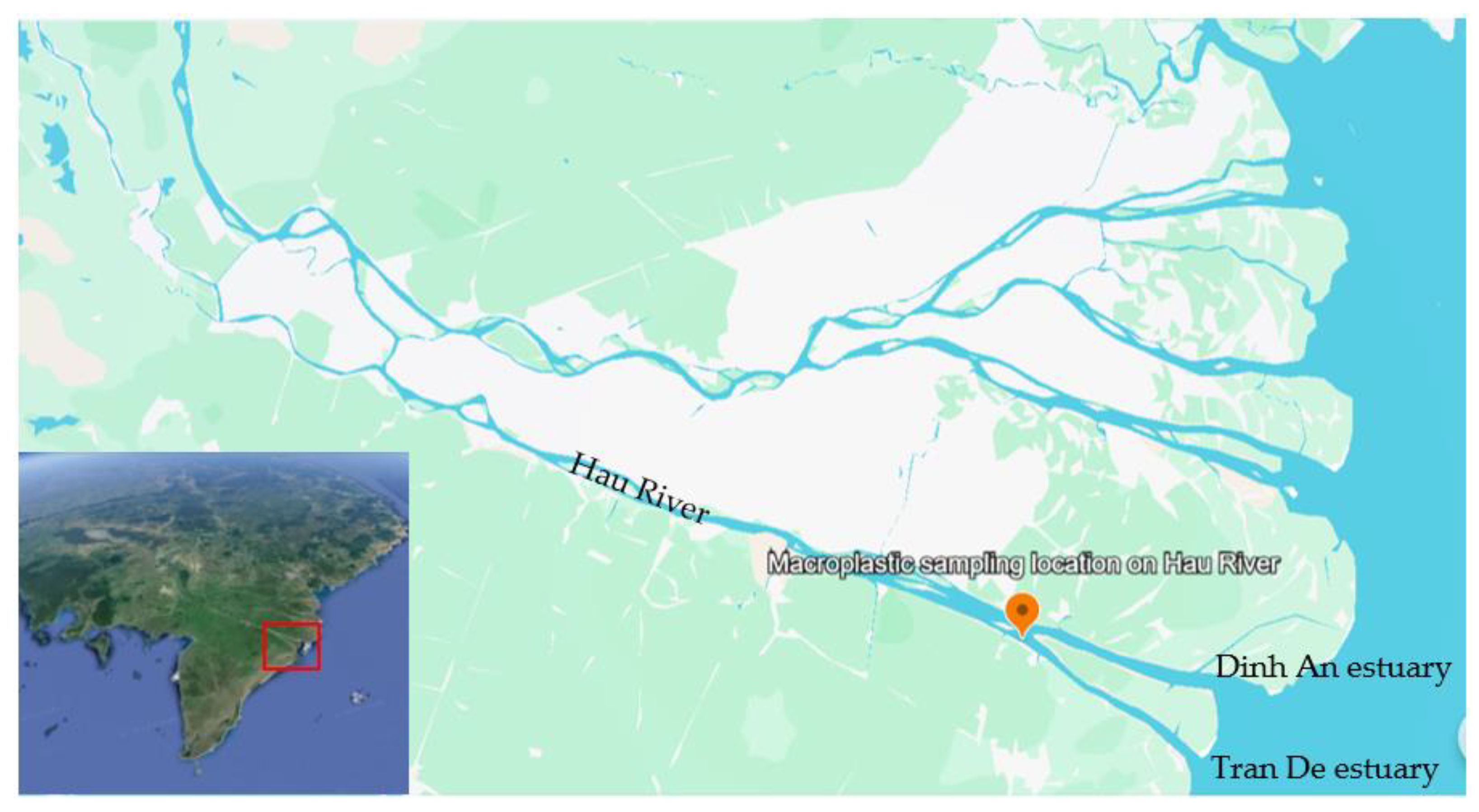
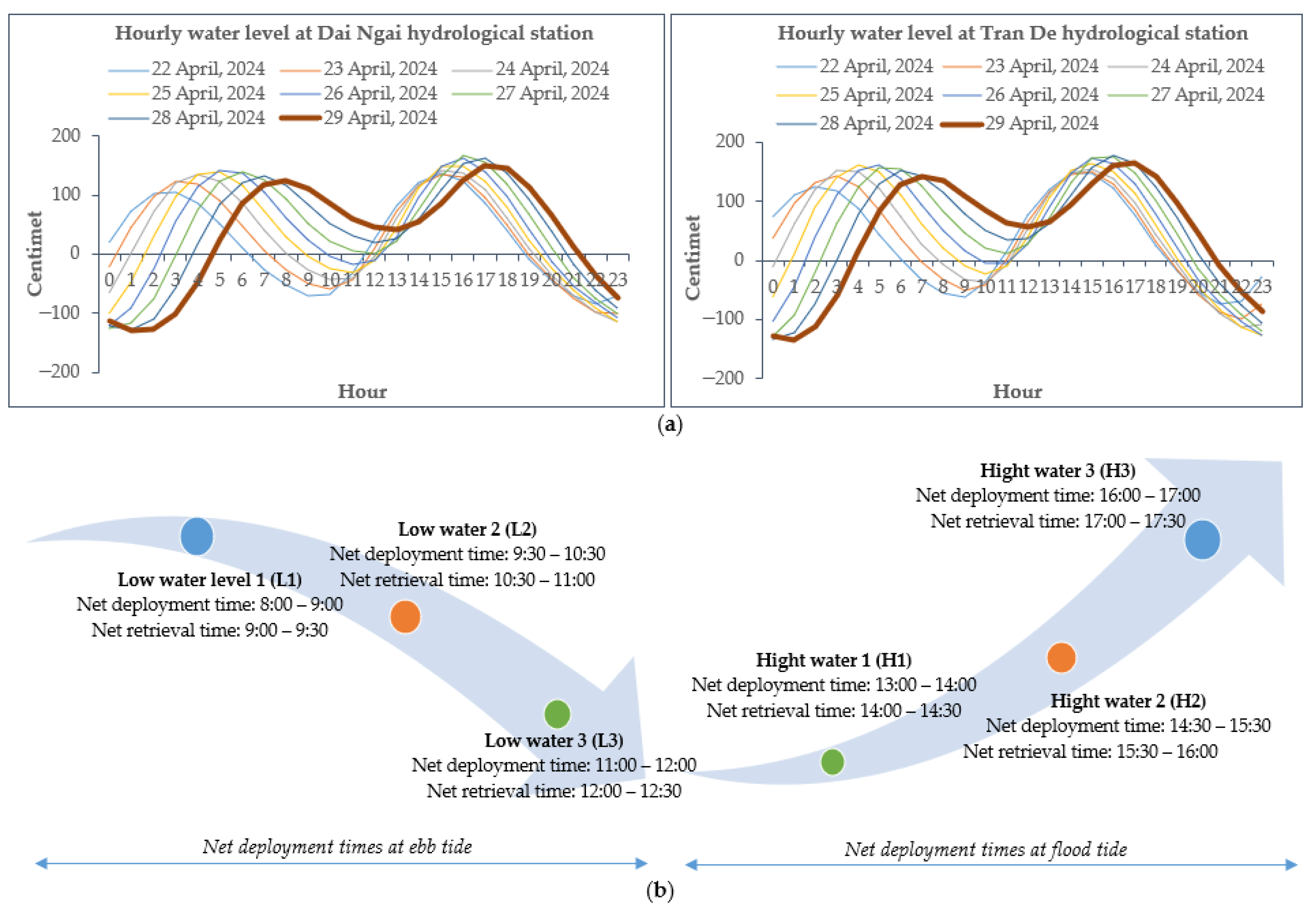
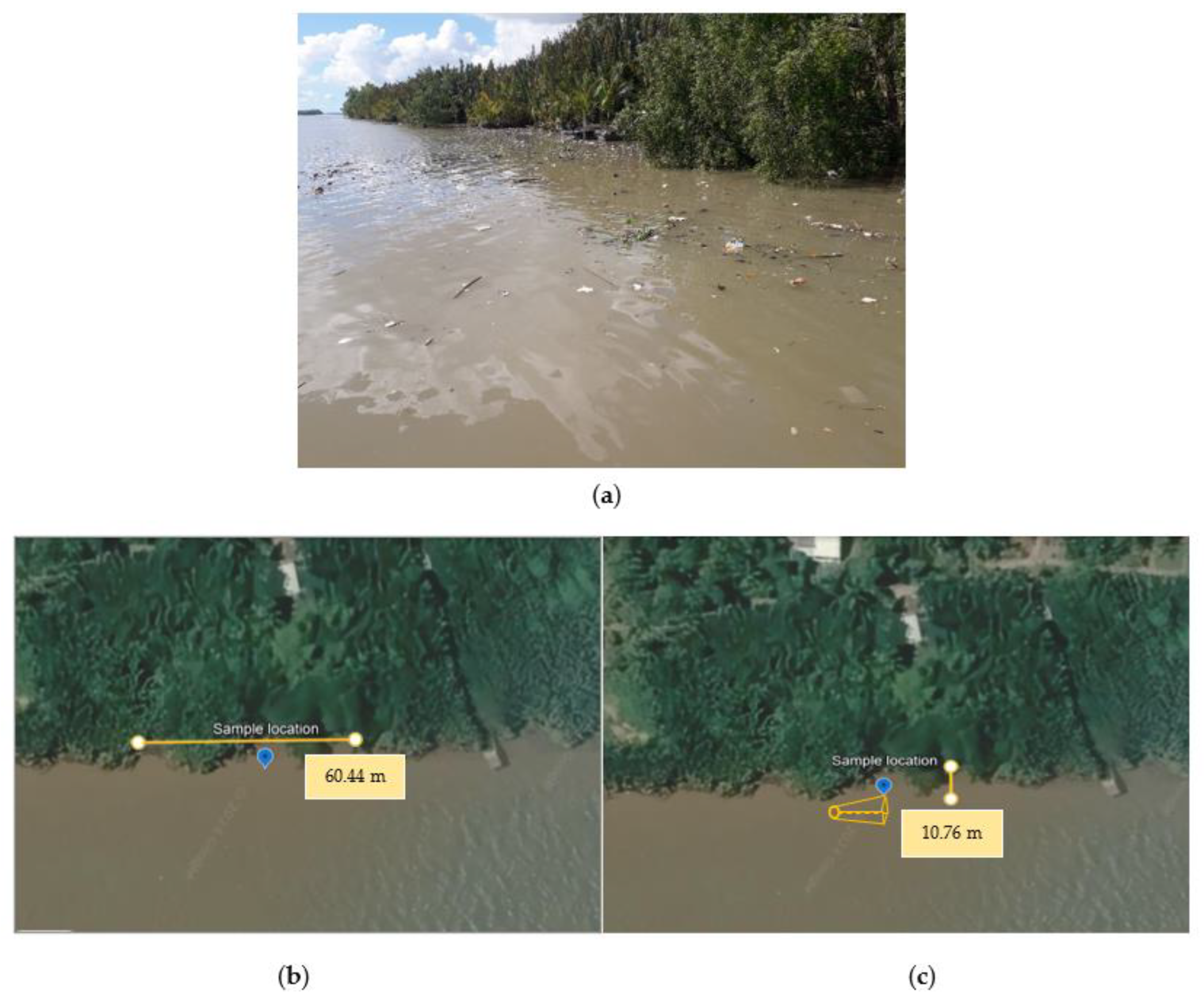
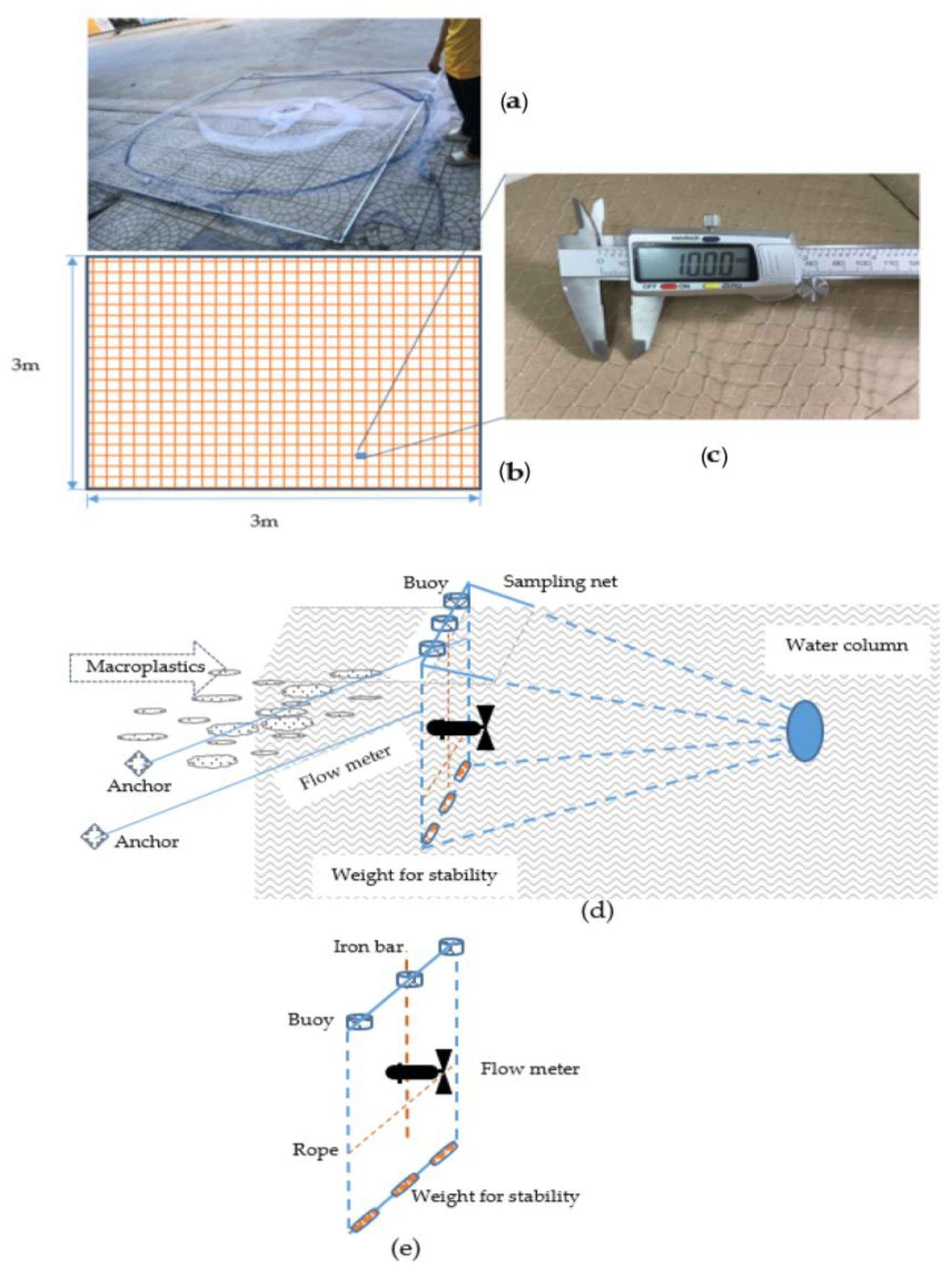
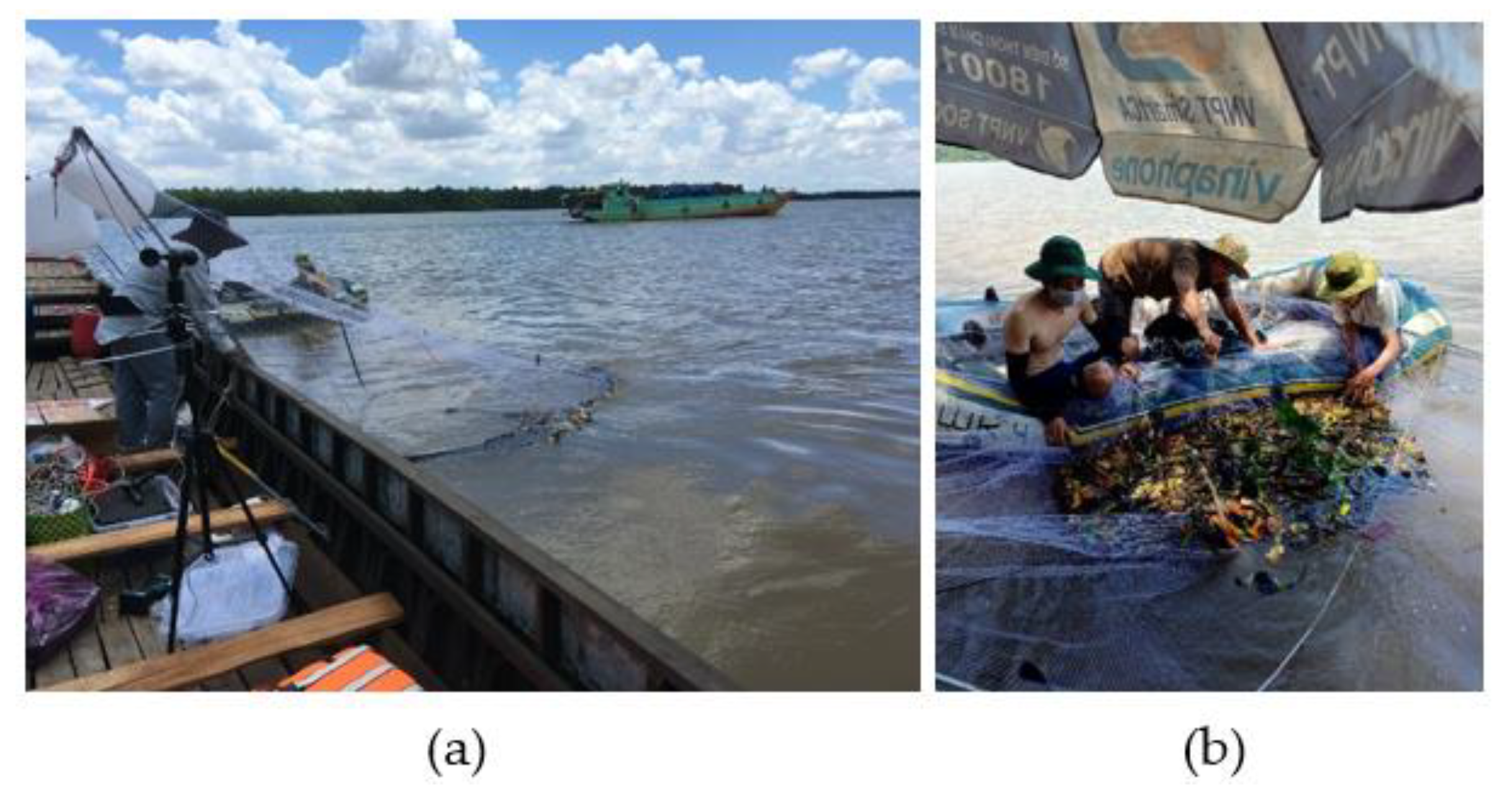

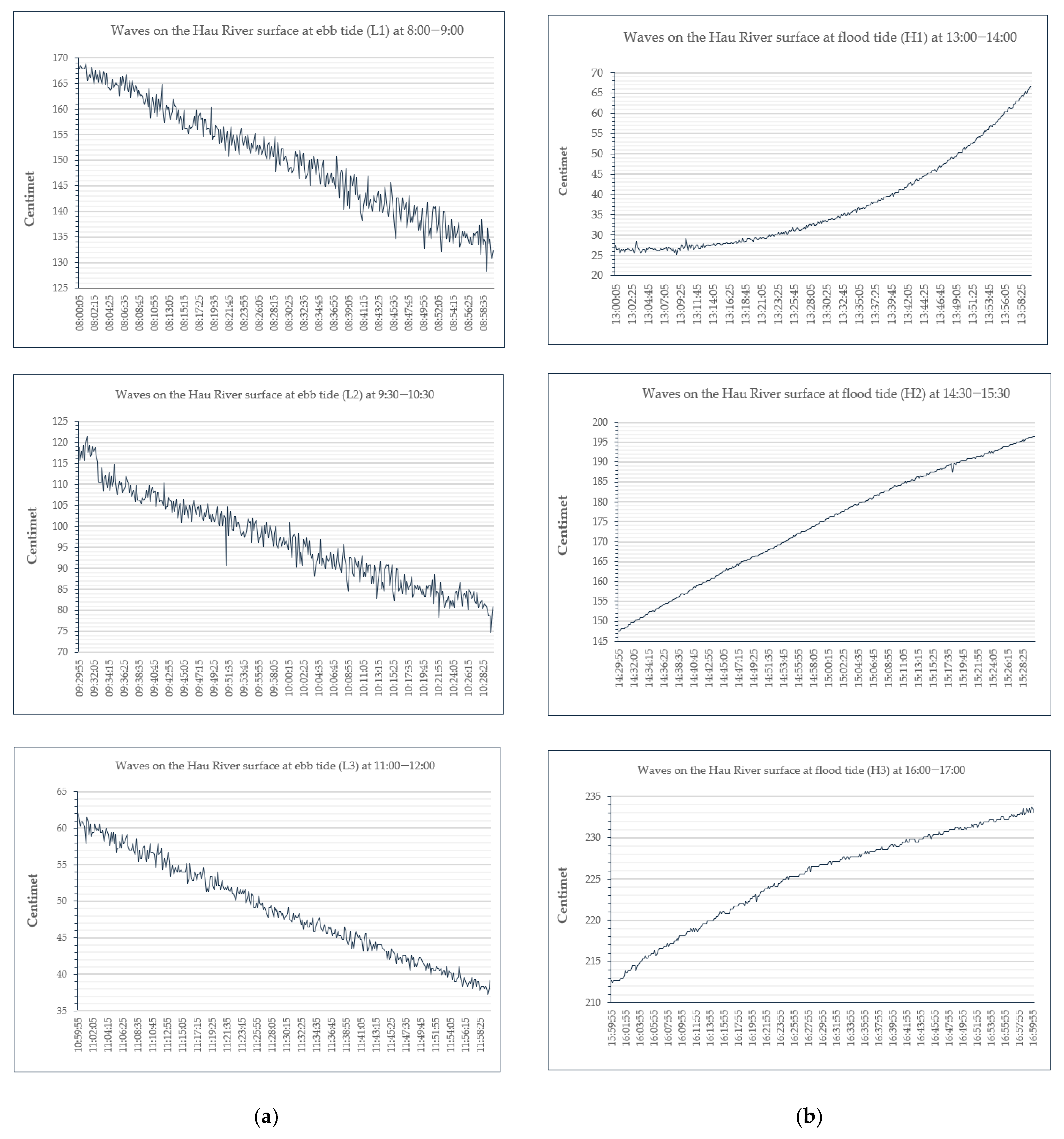
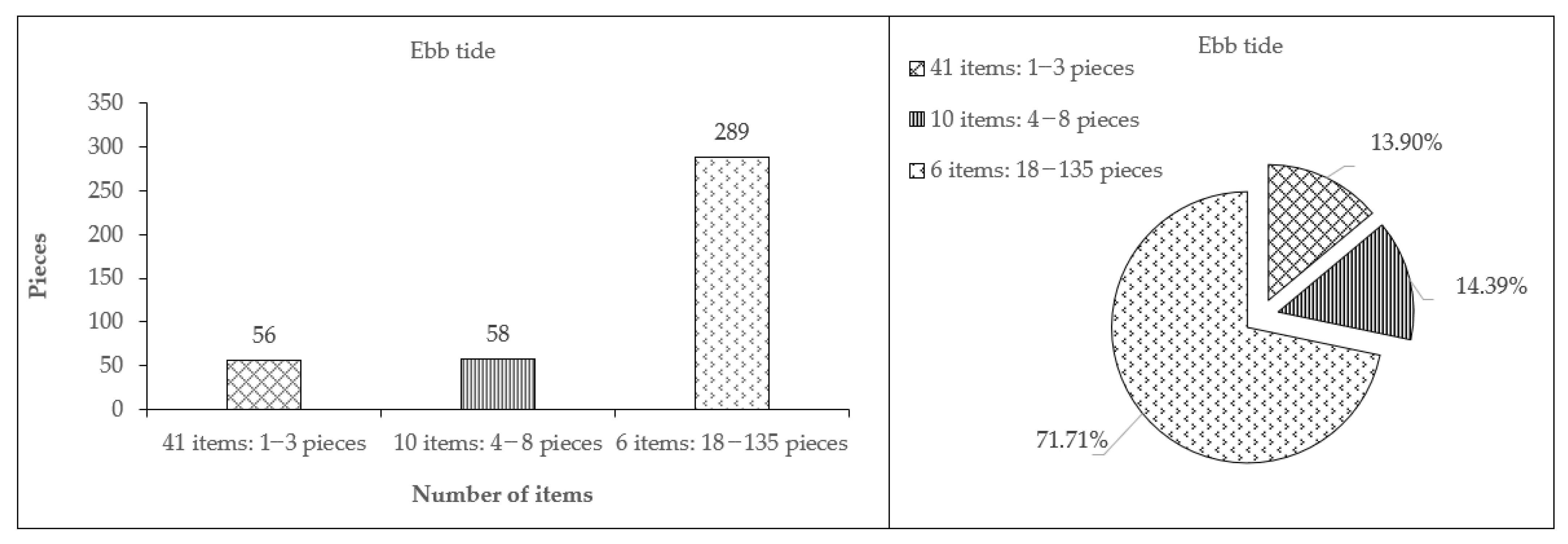
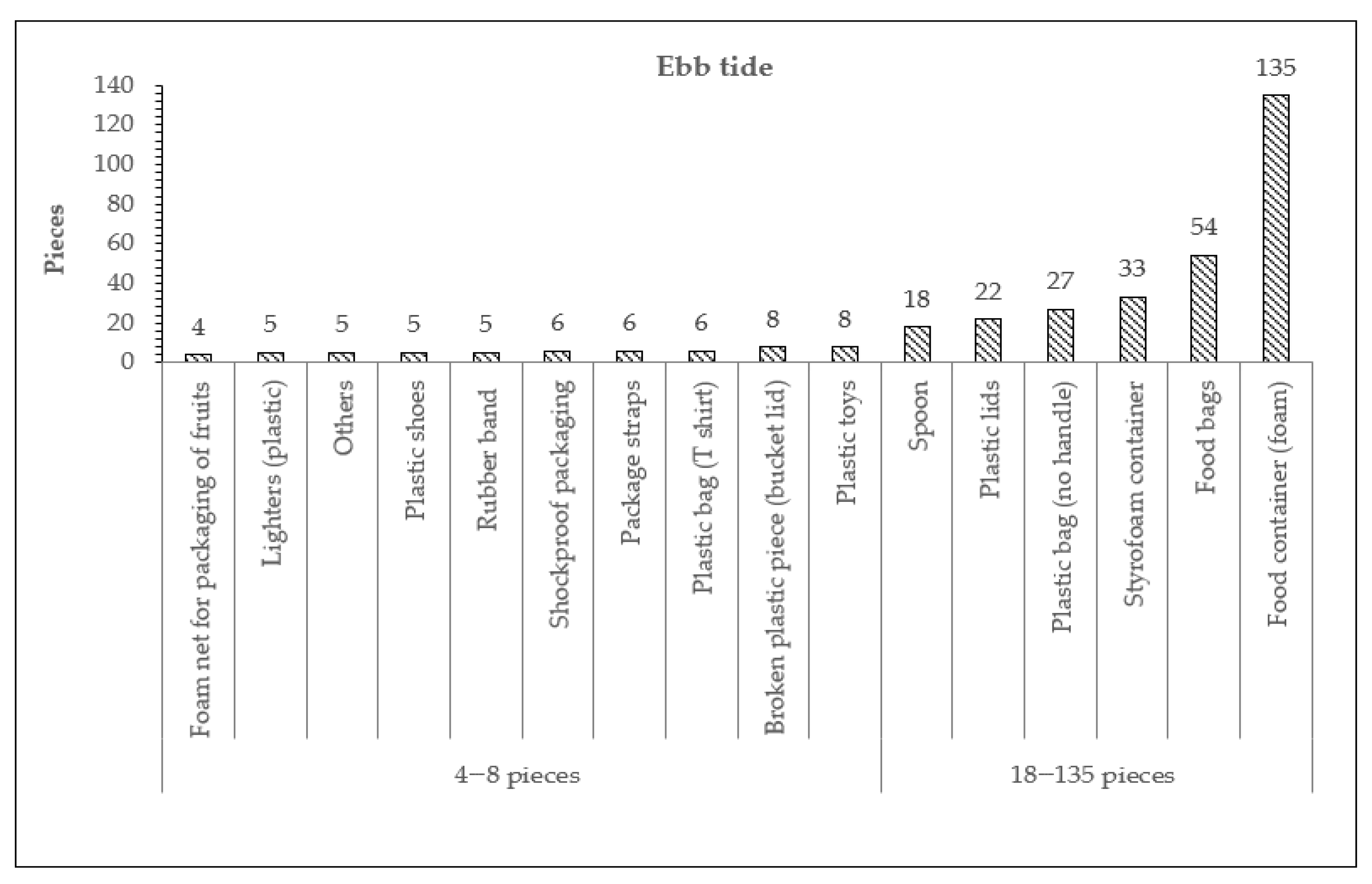
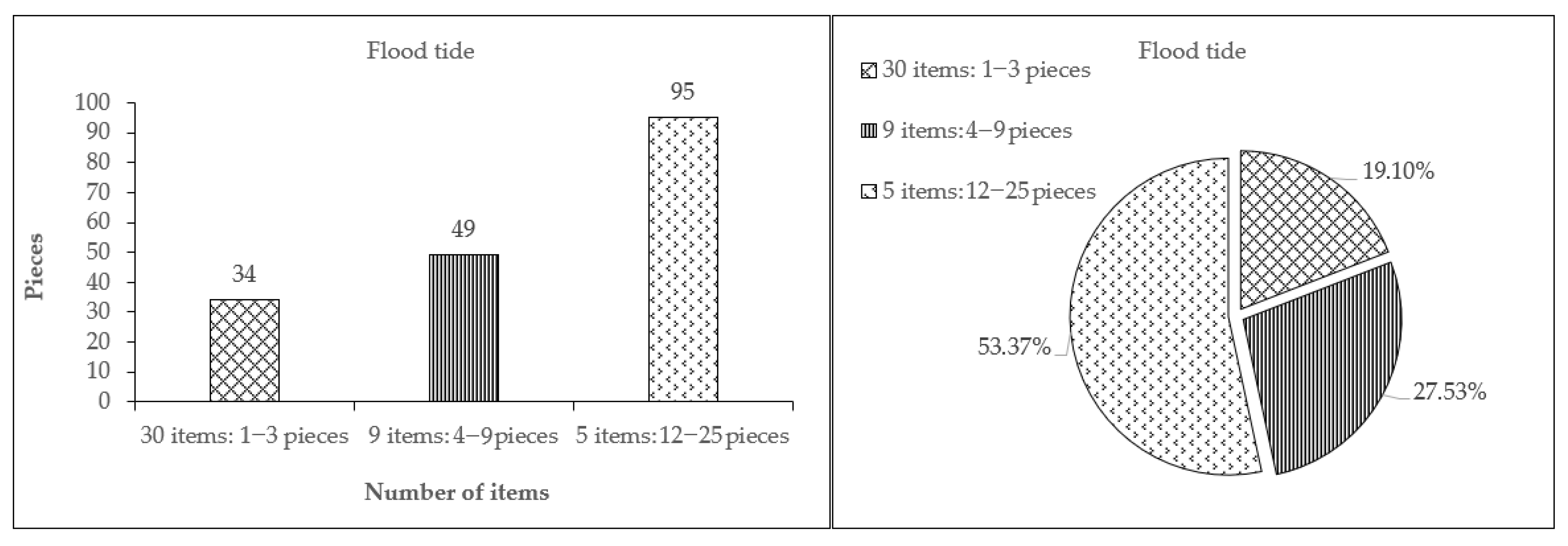

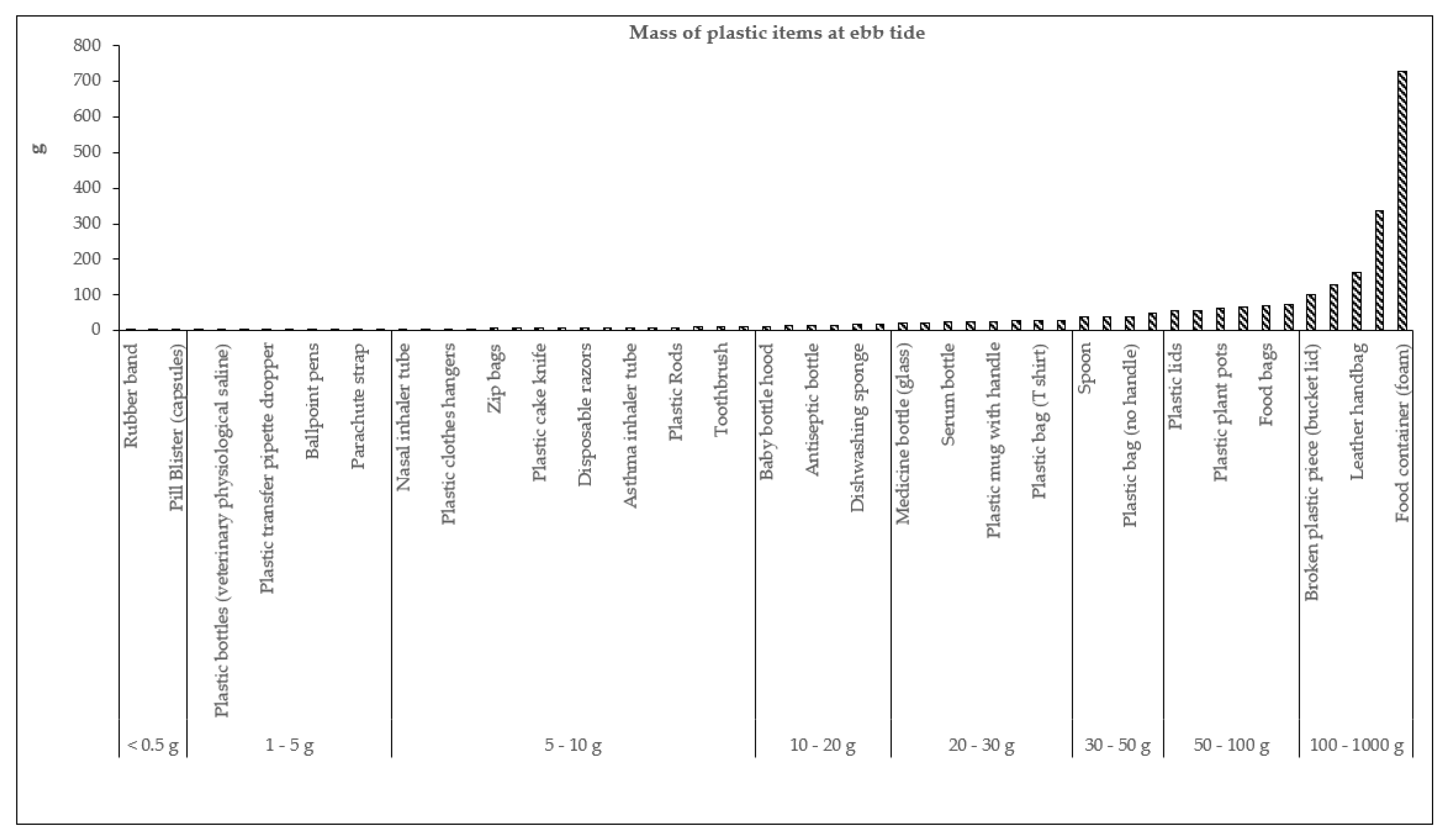
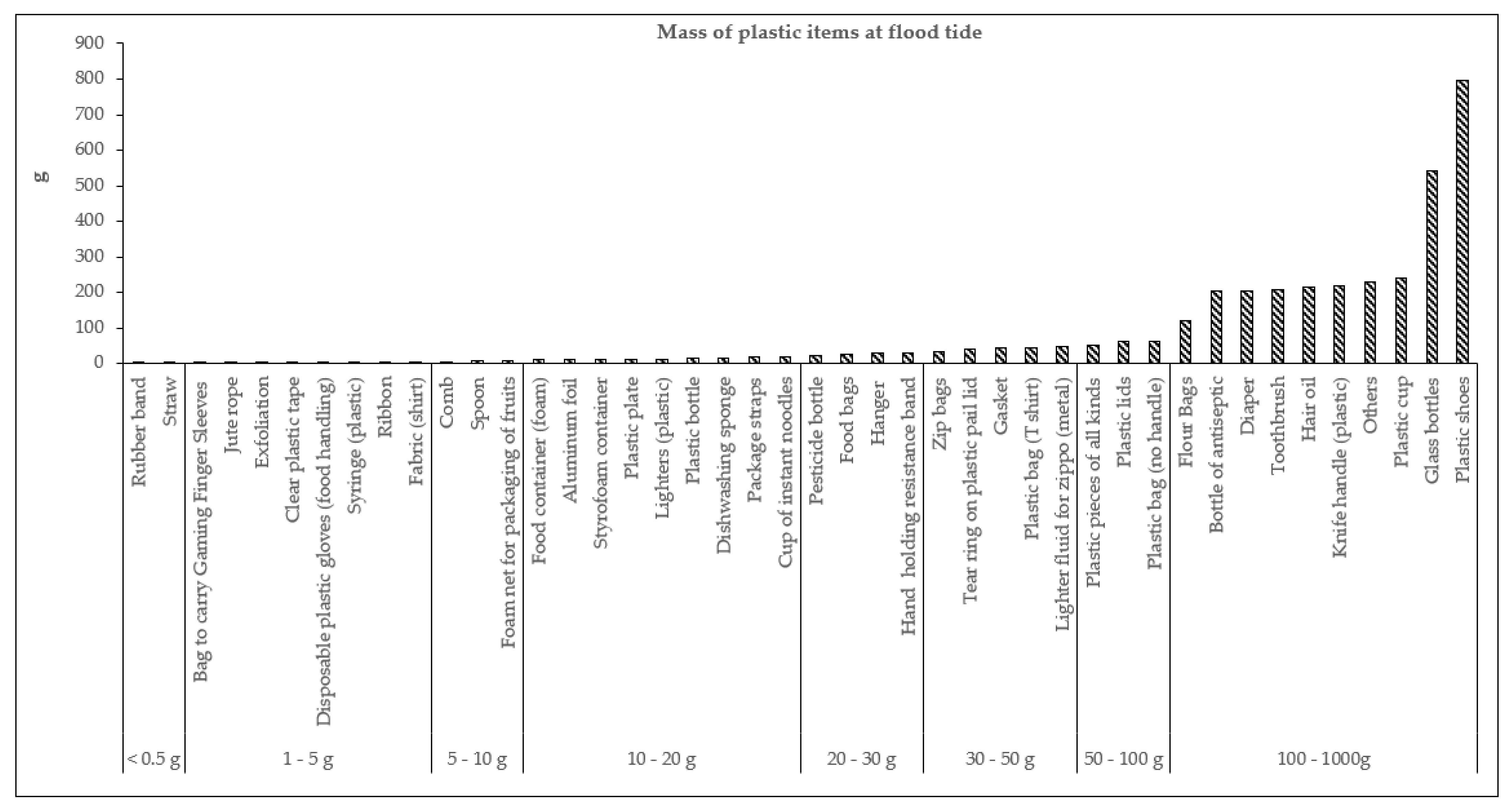

| Classes | Description |
|---|---|
| Mega | >1000 mm |
| Macro | 25 mm–1000 mm |
| Meso | 5 mm–25 mm |
| Micro | <5 mm |
| Variables | Wind Speed (m/s) | Air Humudity (%) | Air Temperature (°C) | Water Velocity (m/s) | Water Volume (m3) | Wave on River (cm) | Pieces/h | Pieces/m3 | g/h | g/m3 | Items/h | Items/m3 | Size (cm) |
|---|---|---|---|---|---|---|---|---|---|---|---|---|---|
| Wind speed (m/s) | 1 | ||||||||||||
| Air humudity (%) | −0.265 | 1 | |||||||||||
| Air temperature (°C) | −0.147 | 0.086 | 1 | ||||||||||
| Water velocity (m/s) | −0.441 | 0.029 | 0.714 | 1 | |||||||||
| Water volume (m3) | −0.441 | 0.029 | 0.714 | 1.000 | 1 | ||||||||
| Wave on river (cm) | 0.147 | −0.086 | −1.000 | −0.714 | −0.714 | 1 | |||||||
| Pieces/h | 0.147 | 0.257 | 0.143 | −0.543 | −0.543 | −0.143 | 1 | ||||||
| Pieces/m3 | 0.530 | 0.029 | −0.314 | −0.886 | −0.886 | 0.314 | 0.829 | 1 | |||||
| g/h | −0.235 | −0.143 | −0.257 | −0.600 | −0.600 | 0.257 | 0.657 | 0.600 | 1 | ||||
| g/m3 | −0.088 | 0.086 | −0.371 | −0.771 | −0.771 | 0.371 | 0.771 | 0.771 | 0.943 | 1 | |||
| Items/h | 0.265 | 0.086 | −0.143 | −0.771 | −0.771 | 0.143 | 0.943 | 0.943 | 0.771 | 0.886 | 1 | ||
| Items/m3 | 0.441 | 0.086 | −0.486 | −0.943 | −0.943 | 0.486 | 0.714 | 0.943 | 0.657 | 0.829 | 0.886 | 1 | |
| Size (cm) | 0.029 | −0.543 | −0.657 | −0.200 | −0.200 | 0.657 | −0.600 | −0.200 | 0.086 | −0.029 | −0.314 | 0.029 | 1 |
| Group | Items |
|---|---|
| 1. Plastic Bags & Wrappers | Plastic Bag (T Shirt), Plastic Bag (Without Handle), Zip Bags, Food Bags, Package Straps |
| 2. Plastic Bottles & Containers | Plastic Bottles (Veterinary Physiological Saline), Glue Bottle (Plastic), Yogurt Bottle, Antiseptic Bottle, Serum Bottle, Cups, Plastic Bowl, Plastic Mug with Handle. |
| 3. Plastic Lids & Caps | Plastic Lids, Plastic Bottle Handle, Baby Bottle Hood. |
| 4. Foamed Plastic (Styrofoam) | Styrofoam Container, Food Container (Foam), Shockproof Packaging, Fruit Foam Net. |
| 5. Plastic Tableware | Spoon, Plastic Cup, Plastic Rice Spoon, Plastic Cake Knife. |
| 6. Plastic Personal Items | Toothbrush, Disposable Razors, Liquid Lipstick, Permanent Marker Pen, Ballpoint Pens, Face Cream Boxes. |
| 7. Plastic Toys & Other Items | Plastic Toys, Plastic Shoes, Plastic Clothes Hangers, Watch Strap (Plastic), LED Headlight Head-Mounted Flashlight, Plastic Plant Pots. |
| 8. Plastic Medical/Scientific | Plastic Tube (Rectal Pump Solution), Plastic Transfer Pipette Dropper, Asthma Inhaler Tube, Nasal Inhaler Tube. |
| 9. Broken/Fragmented Plastics | Broken Plastic Piece (Bucket Lid), Others. |
| 10. Non-Plastic Items | Glass Bottles, Metal Lids, Vaccine Vial (Glass), Rubber Seal Ring, Rubber Band, Leather Handbag. |
| Group | Items |
|---|---|
| 1. Plastic Bags & Wrappers | Plastic bag (Without Handle), Plastic Bag (T Shirt), Food Bags, Zip Bags, Clear Plastic Tape, Flour Bags, Cup of Instant Noodles, Transparent Plastic Jelly Jar, Package Straps. |
| 2. Plastic Bottles & Containers | Plastic Bottle, Pesticide Bottle, Syringe (Plastic), Hair Oil Bottle (Plastic), Bottle of Antiseptic, Fuel Filter (Plastic). |
| 3. Plastic Lids & Caps | Plastic Lids, Plastic Cup. |
| 4. Foamed Plastic (Styrofoam) | Fruit Foam Net, Food Container (Foam). |
| 5. Plastic Tableware | Plastic Plate, Spoon. |
| 6. Plastic Personal Items | Plastic Shoes, Comb (Plastic), Knife Handle (Plastic), Hanger (Plastic), Exfoliation Tube (Plastic), Toothbrush, Dishwashing Sponge, Lighters (Plastic). |
| 7. Broken/Fragmented Plastics | Plastic Pieces of All Kinds, Tear Ring on Plastic Pail Lid, Others. |
| 8. Personal & Sanitary Items | Diaper, Disposable Plastic Gloves (Food Handling), Hand Holding Resistance Band. |
| 9. Textile & Fiber Items | Fabric (Shirt), Jute Rope, Ribbon. |
| 10. Non-Plastic Items | Glass Bottles, Rubber Band, Gasket, Aluminum Foil, Lighter Fluid for Zippo (Metal). |
| L1 | L2 | L3 | H1 | H2 | H3 | |
|---|---|---|---|---|---|---|
| Pieces/h | 49 | 340 | 14 | 71 | 48 | 59 |
| Water volume (m3) | 2.83 | 2.54 | 7.22 | 5.40 | 4.45 | 1.22 |
| Pieces/m3 | 17 | 134 | 2 | 13 | 11 | 48 |
| Average (pieces/h) | 134 | 59 | ||||
| Average (pieces/m3) | 51 | 24 | ||||
| Total (pieces) | 403 | 178 | ||||
| L1 | L2 | L3 | H1 | H2 | H3 | |
|---|---|---|---|---|---|---|
| kg/h | 0.19 | 1.97 | 0.27 | 0.92 | 0.38 | 2.34 |
| Water volume (m3) | 2.83 | 2.54 | 7.22 | 5.40 | 4.45 | 1.22 |
| kg/m3 | 0.07 | 0.78 | 0.04 | 0.171 | 0.09 | 1.92 |
| Average (kg/h) | 0.81 | 1.22 | ||||
| Average (kg/m3) | 0.29 | 0.73 | ||||
| Total (kg) | 2.43 | 3.65 | ||||
Disclaimer/Publisher’s Note: The statements, opinions and data contained in all publications are solely those of the individual author(s) and contributor(s) and not of MDPI and/or the editor(s). MDPI and/or the editor(s) disclaim responsibility for any injury to people or property resulting from any ideas, methods, instructions or products referred to in the content. |
© 2025 by the authors. Licensee MDPI, Basel, Switzerland. This article is an open access article distributed under the terms and conditions of the Creative Commons Attribution (CC BY) license (https://creativecommons.org/licenses/by/4.0/).
Share and Cite
Thanh, N.T.; Minh, H.V.T.; Lavane, K.; Vo Chau Ngan, N.; Toan, P.V.; Ty, T.V.; Duy, D.V.; Toan, V.T.; Kumar, P. From River to Sea: Tracking Plastic Waste Transport via the Hau River, Mekong Delta, Vietnam. Water 2025, 17, 2438. https://doi.org/10.3390/w17162438
Thanh NT, Minh HVT, Lavane K, Vo Chau Ngan N, Toan PV, Ty TV, Duy DV, Toan VT, Kumar P. From River to Sea: Tracking Plastic Waste Transport via the Hau River, Mekong Delta, Vietnam. Water. 2025; 17(16):2438. https://doi.org/10.3390/w17162438
Chicago/Turabian StyleThanh, Nguyen Truong, Huynh Vuong Thu Minh, Kim Lavane, Nguyen Vo Chau Ngan, Pham Van Toan, Tran Van Ty, Dinh Van Duy, Vo Thanh Toan, and Pankaj Kumar. 2025. "From River to Sea: Tracking Plastic Waste Transport via the Hau River, Mekong Delta, Vietnam" Water 17, no. 16: 2438. https://doi.org/10.3390/w17162438
APA StyleThanh, N. T., Minh, H. V. T., Lavane, K., Vo Chau Ngan, N., Toan, P. V., Ty, T. V., Duy, D. V., Toan, V. T., & Kumar, P. (2025). From River to Sea: Tracking Plastic Waste Transport via the Hau River, Mekong Delta, Vietnam. Water, 17(16), 2438. https://doi.org/10.3390/w17162438











